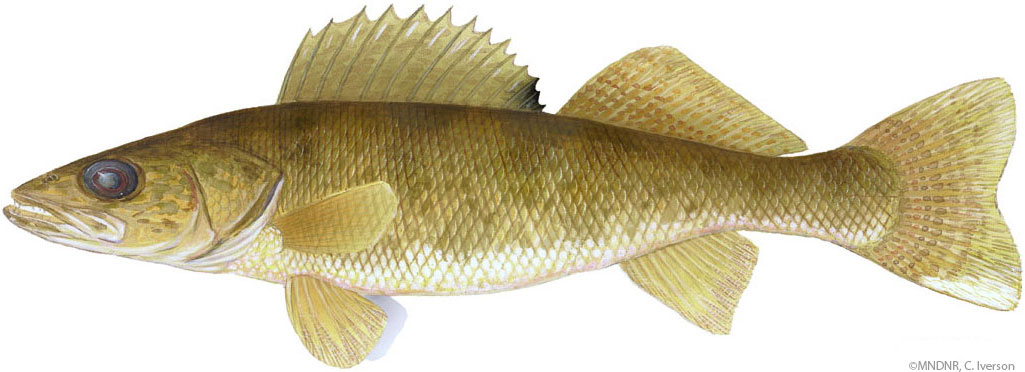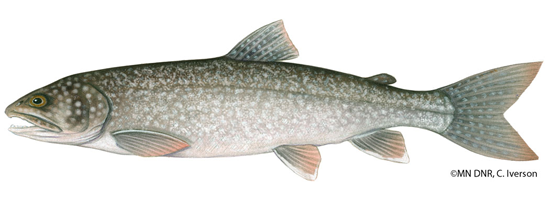Fishing in the Boundary Waters
The Boundary Waters Canoe Area (BWCA) Wilderness offers world-class fishing opportunities. Known for its clear waters and remote, untouched beauty, the BWCA is home to a variety of fish, including walleye, northern pike, smallmouth & largemouth bass, and lake trout.
Walleye

Lures
- Jigs: Use 1/8 oz to 1/4 oz jigs in bright colors like chartreuse, white, or orange. Tip with a live minnow, leech, or soft plastic (like a paddle tail).
- Crankbaits: Shallow-diving crankbaits in natural fish patterns (like silver or perch) can be great.
- Live Bait: Leeches, nightcrawlers, or minnows.
Techniques
- Drifting and Jigging: Use a drift along the shoreline or in deeper water (12-20 feet) with jigs tipped with live bait.
- Slip Bobber: Use this technique in deeper water or around structure like drop-offs or submerged rocks. A slip bobber allows you to adjust the depth of your bait easily.
- Casting: For more active fishing, cast jigs and crankbaits along the edges of drop-offs or near submerged rocks and points.
Best Times to Fish
- Early Morning & Late Evening: Walleye are most active during low light periods, typically at dawn and dusk.
- Mid-day: Can also be productive in deeper water when walleye retreat to cooler spots.
Location Tips
- Shorelines & Drop-offs: Look for walleye near drop-offs, points, and underwater structures like sunken rocks or weeds.
- Shallow Water Early/Deep Water Mid-day: In warmer months, walleye may be in shallow water in the morning and move to deeper, cooler spots as the day heats up.
Northern Pike

Lures
- Spinnerbaits: Large, flashy spinnerbaits in bright colors (chartreuse, white, or red) can draw pike’s attention in both shallow and deeper water.
- Crankbaits & Lipless Crankbaits: Use large, loud crankbaits in bright patterns like fire tiger or shad to mimic the pike’s natural prey.
- Spoons: Large spoons like the Johnson Silver Minnow or Swedish Pimple can be effective, especially when jigged in deeper waters.
- Topwater Lures: Large, noisy topwater lures like buzzbaits or poppers can provoke aggressive strikes, especially in low light conditions.
Techniques
- Casting & Retrieving: Cast spinnerbaits, crankbaits, or topwater lures along the edges of weed beds, drop-offs, and points. Vary the retrieve speed and use erratic motion to entice strikes.
- Trolling: This technique is effective for covering large areas. Troll larger lures like deep-diving crankbaits or spoons behind your canoe at varying speeds, especially around drop-offs, humps, and structures.
- Jigging: In deeper water, use spoons or heavy jigs to target pike that are holding near the bottom or structures like submerged rocks.
Best Times to Fish
- Early Morning & Late Evening: Pike are most active during low-light periods, so fish at dawn or dusk for the best chances.
- Overcast Days: Pike are less wary on cloudy days and can be more active throughout the day.
- Mid-day (Hot Weather): When the sun is high and the water is warm, pike tend to move to deeper, cooler waters, so focus on drop-offs or submerged structures.
Location Tips
- Weed Beds & Shallow Water: Northern pike love to lurk in and around thick weed beds, especially near shallow areas with access to deeper water.
- Drop-offs & Points: Look for pike near steep drop-offs, submerged rocks, or points where they can ambush prey.
- Islands & Humps: These underwater structures often provide great ambush spots for pike, especially when trolling.
Bass

Lures
- Jigs: Use 1/8 oz to 1/2 oz jigs, especially in colors like black, brown, or green pumpkin. Tip with a soft plastic trailer like a creature bait or craw.
- Topwater Lures: Frogs, poppers, and buzzbaits work well early morning or evening when bass are near the surface.
- Crankbaits & Lipless Crankbaits: Shallow-diving crankbaits in natural fish colors or lipless crankbaits for covering deeper water.
- Soft Plastics: Wacky-rigged worms, Texas rigs with craws, and Senkos are good choices for a slower presentation.
Techniques
- Casting & Retrieving: Cast topwater lures, crankbaits, and soft plastics along the edges of shorelines, rocks, or submerged structures. Retrieve at varying speeds depending on the lure and the bass’s activity level.
- Jigging: Use jigs tipped with soft plastics to work through submerged structures or around rocks and brush.
- Carolina Rigging: Ideal for deeper water or slower presentations. Use a weight, bead, and hook to present soft plastics off the bottom.
Best Times to Fish
- Early Morning & Late Evening: Bass are more active and more likely to hit topwater lures or shallow-water baits during these times.
- Mid-day: Bass may retreat to deeper structures when it’s hot, so focus on deeper, cooler spots with jigs or soft plastics.
Location Tips
- Shorelines & Cover: Bass love to hang around structure like submerged rocks, fallen trees, weed beds, and points.
- Deeper Water (during hot weather): When water temps rise, bass often move to cooler, deeper water. Look for them near drop-offs, ledges, or submerged humps.
- Shallow Water (early in the day): In the morning, focus on shallow areas near shoreline cover or weed beds.
Lake Trout

Lures
- Spoons: Heavy spoons (Swedish Pimple, Little Cleo) work well for deep-water jigging.
- Jigs: Large jigs (1/2 oz to 1 oz) tipped with minnows or soft plastics.
- Crankbaits: Deep-diving crankbaits in natural patterns like perch or shad.
Techniques
- Jigging: Drop spoons or jigs into deep water (20-40 feet), and use short, erratic lifts to mimic struggling prey.
- Trolling: Slow troll with deep-diving crankbaits or spoons at 1.5-2 mph to cover deeper areas.
- Casting: Cast large jigs or spoons near submerged structures like points or islands, particularly in spring or fall.
Best Times to Fish
- Early Spring & Fall: Lake trout move closer to shore and are more active in colder water.
- Summer: Fish deeper (30-50+ feet) when lake trout retreat to cooler waters.
- Dawn & Dusk: Lake trout are more active in low light, especially on warmer days.
Location Tips
- Deep Water: Look for lake trout in 20-40 feet of water, even deeper during warmer months.
- Drop-offs & Underwater Structures: Focus on drop-offs, submerged humps, and points where lake trout can ambush prey.
- Cold, Clear Lakes: Lake trout prefer clear, oxygen-rich, cold water and thrive in deep, cool lakes.


